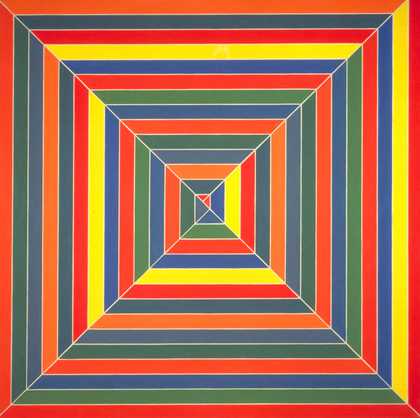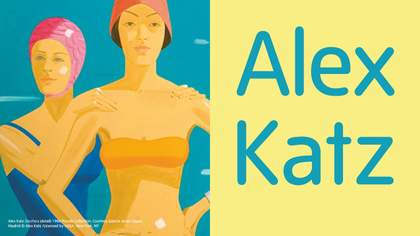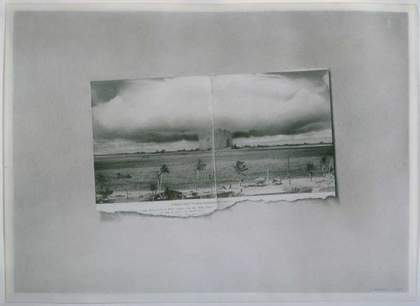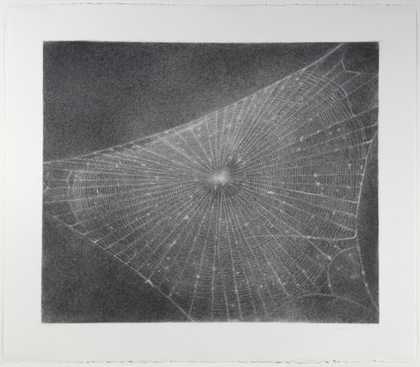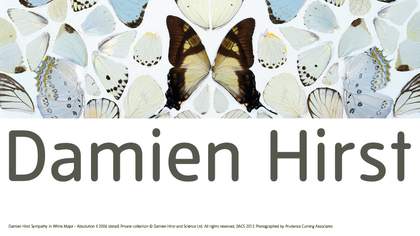ARTIST ROOMS was donated to the National Galleries of Scotland (NGS) and Tate by the dealer and collector Anthony d’Offay in 2008, and was acquired with the support of the National Heritage Memorial Fund, the Art Fund and the Scottish and British governments. Anthony d’Offay’s vision for ARTIST ROOMS was that world-class modern and contemporary art should be made available to audiences nationwide through monographic exhibitions and displays that, it was hoped, would inspire future generations. Supported by the Art Fund and the Scottish government, the national touring programme was inaugurated in 2009 and involved twelve museums and galleries (referred to as associates) across the United Kingdom who were invited to work with the collection as part of ARTIST ROOMS On Tour. NGS and Tate also showed multiple ARTIST ROOMS displays in 2009, which were developed in tandem with learning programmes.
The tour of the collection is framed by the ambition to show the holdings as widely as possible, across all parts of the UK, and to engage audiences with the artworks, particularly young people and marginalised groups. Learning is fundamental to the project and each associate venue is required to set out a programme of learning activities. During the first year of ARTIST ROOMS more than 10,400 learner contacts were made at regional galleries across the UK; if the figures for NGS and Tate are included, the total was 63,804. A significant proportion of these learners were young people and many were from areas of deprivation.
The 2009 associate galleries were diverse. In terms of geography they ranged from Pier Arts Centre in Stromness, Orkney, to the De La Warr Pavilion in Bexhill-on-sea in East Sussex. Some operated under the auspices of local authorities, others were run by universities and charitable trusts. Some were museums that normally showed historical and social artefacts, others had a track record of exhibiting modern art. Despite these different contexts, the associates’ activities and methods of engagement had points in common and offer a basis for review and reflection, as this report seeks to show. It should be noted that as a UK-wide project, ARTIST ROOMS offers a rare opportunity to explore learning and engagement in the formal and informal sectors, cutting across boundaries generated by broad governance structures, particularly those existing between the different educational systems in Scotland, England, Wales and Northern Ireland.
1. ARTIST ROOMS and learning
The ARTIST ROOMS team
The ARTIST ROOMS team is comprised of a Managing Curator, Learning Coordinator, Registrar and Programme Coordinator. This small team reports to both Tate and NGS, irrespective of where members are located. The Managing Curator, Registrar and Programme Coordinator are currently based at Tate’s Millbank site and spend regular periods of time working at NGS in Edinburgh. The Learning Coordinator is based at NGS and spends regular periods of time at Tate. Curatorial interns are also employed to work on aspects of the project at both organisations from time to time. The Learning Coordinator works closely with the ARTIST ROOMS team, associates, new media and learning teams at Tate and NGS.
Funding
The Art Fund agreed to support ARTIST ROOMS from 2009 to 2012 with a grant of £250,000 p.a. to contribute to the running costs of the project. In 2009 and 2010 this provided funding allocations to associates in England, Wales and Northern Ireland, and in 2011 and 2012 supported allocations to all associates across the UK. In 2008 the Scottish Government increased NGS’s running costs by £175,000 p.a. for three years, supporting the galleries’ infrastructure, the post of a Learning Coordinator for ARTIST ROOMS and funding for associates in Scotland for 2009–10. In 2009 each host venue received a fixed allocation of £5,000 to enhance education, PR and marketing. In addition, up to £10,000 was available by application to cover special initiatives in these areas, and, where a special need was demonstrated, to contribute to exceptional transport and installation costs.
Cultural learning and young people
In 2000 the British government determined education to be a priority for museums and galleries.1 As a consequence, there has been a proliferation of educational initiatives that have seen cultural venues engage with new audiences and become more democratic and inclusive spaces. Museum educators are increasingly being given equal status to curatorial staff, and the UK is regarded as leading the world in the practice of art museum and gallery education.2
With the prioritising of education, museums and galleries in the UK have witnessed a substantial increase in the number of young visitors and learners that they are able to attract. However, despite the changes in the cultural sector and an increase in learning activities, young people are still an under-represented minority. Negative perceptions of cultural venues, in part because of a perceived gulf between ‘youth/popular’ and ‘adult/high’ arts,3 can make young people reticent to join in, and can make them a less attractive group to work with.
The United Nations Convention on the Rights of the Child recognises that there is a distinction between the term child and ‘youth’ or ‘teenagers’ but uses the term ‘young person’ to define both groups.4 Within cultural learning ‘young people’ is now widely used to refer to youths or teenagers. This is reflected in government policy documents and job titles in the cultural sector. ARTIST ROOMS defines young people, its priority audience, as aged 13–25. Although there is an emphasis on this age group, it is not intended to be at the expense of children or lifelong learners.
ARTIST ROOMS is premised upon the idea that art can transform lives, and the core aim is to use the collection in ways that will engage new audiences of young people, including marginalised groups. Anthony d’Offay hopes the rooms will replicate ‘the experience that defined his life’, when as a school child he encountered art at New Walk Museum and Art Gallery, Leicester, and then, as a student, at the National Gallery of Scotland in Edinburgh. Learning and outreach activities are therefore paramount to the project, and associates are encouraged to explore innovative ways of working to offer audiences routes into the ARTIST ROOMS collection in ways that best suit them and the needs of those audiences, and reflect the exceptional and pioneering nature of the collection itself.
What is meant by learning within the cultural sector is defined in a variety of ways by educational and cultural bodies. Many gallery professionals and artists define arts education in its widest sense as the process by which we engage with the art.5 Definitions often encompass initiatives such as ‘lifelong learning’ and reflect different learning styles and methods of engagement and contexts: formal, non-formal and informal. Non-formal learning is structured and organised but does not necessarily lead to a qualification. Informal learning occurs through family, social or civic life.6
In recent years there has been a shift from the term ‘education’ within the cultural sector to the term ‘learning’. This reflects a move away from traditional didactic notions of education. Eilean Hooper-Greenhill, an internationally recognised scholar on museums, education and communication, has written: ‘The use of the word “learning” indicates an increased focus on the learning processes and outcomes of the users, and a shift away from thinking about the museum and its educational delivery’.7 Learning thus suggests that the provision is delivered from a visitor’s or user’s perspective, while education implies an organisational construct describing a service commitment to transfer knowledge to someone.8
NGS and Tate have developed a shared definition of learning about art within the project as a process allowing ‘a physical, intellectual, emotional or creative connection with art in a meaningful, enjoyable and potentially life-changing manner’. Both organisations recognise that many learning experiences are implicit and not necessarily something that can be gauged or evaluated. Informal learning is seen as important but, as authors Carey Oppenheim and Kate Bellamy have noted, ‘the benefits of informal learning for children and young people will need to be more widely known about if it is to be accepted on an equal footing with formal learning’.9
ARTIST ROOMS learning aims
ARTIST ROOMS has four learning aims:
- To engage ‘new’ young audiences (13–25 year-olds) across the UK with the ARTIST ROOMS collection and artists in a meaningful and enjoyable way.
- To establish and maintain effective collaborations between curators, educators and other gallery staff to maximise the potential of ARTIST ROOMS and realise its key objectives.
- To build and make available a body of learning material and resources for young people and about young people connecting with ARTIST ROOMS.
- To explore sustainable ways of developing and maintaining communities of young learners engaged in ARTIST ROOMS and contemporary art.
The ARTIST ROOMS learning aims support the notion that gallery education should be both enjoyable and challenging. Our experience has shown that the strongest learning programmes are produced through working in partnership, especially where input from learning staff is fed into interpretation (and that of curatorial staff into learning programmes). NGS and Tate believe that the wealth of material being produced by young people and gallery professionals, if shared and disseminated, can help sustain and develop curatorial practice as well as enhance learning activities.
ARTIST ROOMS learning outcomes
In the early stages of the project, draft Generic Learning Outcomes (GLOs) were developed by Education and Learning staff at NGS and Tate. These have three key messages:
- Art is exciting, relevant, interesting, challenging, thought-provoking and inspiring.
- Engaging with art can challenge our views, ideas, the ways in which we understand the world, and our appreciation of ourselves and our era.
- Modern and contemporary art can make us think about things we might not otherwise consider in our daily lives.
The ARTIST ROOMS GLOs contain suggested methods of delivery and interpretation of the collection, and include guided visits, workshops, talks, debates, teachers’ and lecturers’ notes and paper-based or digital resources. To date these GLOs have not yet been systematically applied. Although many associate educators welcomed them, they also indicated they may restrict the education projects they develop.
2. ARTIST ROOMS On Tour
ARTIST ROOMS 2009 touring programme
ARTIST ROOMS On Tour with The Art Fund is a pioneering partnership that has enabled NGS and Tate to share the collection. In 2009 and 2010, the programme was funded by the Art Fund in England, Wales and Northern Ireland and by the Scottish government in Scotland. As stated above, the first year of ARTIST ROOMS brought together over 10,400 learner contacts at a dozen associate venues, while over 400 workshops and other learning activities were related to exhibitions that were part of the ARTIST ROOMS tour through the associates’ tailor-made outreach programmes.
Areas of priority for ARTIST ROOMS On Tour were developed in addition to the core aims of the collection in order to assist associates when developing applications for additional funding. These areas of priority are:
- to support organisations in developing ambitious curatorial and learning programming
- to encourage imaginative uses of the collection
- to develop resources relating to the collection that can be shared nationally
- to foster partnerships and collaboration.
How the collection was used to engage audiences was left open to associates, as was the definition of young people. Associates were asked to provide documentation on exhibition data (exhibition visitor numbers, visitor profile and feedback), learning and outreach programming (learning outcomes, target audience, participant feedback and programme statistics), and PR, marketing and branding (local press coverage, signage, printed material and cultivation events) once their projects and exhibitions had been completed.
ARTIST ROOMS On Tour provided an opportunity for NGS, Tate and associate galleries to deliver on policies set by the Scottish and British governments relating to artistic and cultural excellence (for example, Learning Outside the Classroom and Supporting Excellence in the Arts). Partnerships formed by the project also helped to establish and foster new relationships between galleries so that good practice could be shared. Most importantly, ARTIST ROOMS On Tour provided opportunities for galleries to work with a range of world-famous artists and artworks rarely seen outside London and Edinburgh, which were used to attract and engage new audiences.
Associate learning overview
In 2009 associate galleries embarked on a range of projects to engage audiences in both formal and informal contexts. For example, several galleries initiated learning projects that helped sustain and develop youth forums and young curators’ groups, while others used the project as an opportunity to establish relationships with local schools, colleges and universities. Learning projects at a number of galleries in both England and Scotland were invested in the national curricula and added value to initiatives such as the Creative Media Diploma (established by the Department for Culture, Media and Sport and the Arts Council England). Galleries also hosted extensive programmes of talks and lectures, and published a variety of printed resources, including interpretation guides and teachers’ packs.
Below are two evaluative case studies of learning initiatives coordinated by associate galleries:
In the Flesh, Aberdeen Art Gallery
Exhibition: Ron Mueck, 29 September – 31 October 2009
Partners: Arts Education Team, Aberdeen City Council
Young people: Secondary school pupils from Aberdeen Grammar, Hazlehead Academy and Kincorth Academy (13–14 year-olds).
An artist was placed in each of the participating schools to encourage interdisciplinary learning (through dance, drama and visual arts) on the theme of ‘body image’, using work from the Ron Mueck exhibition and other contemporary artworks in the gallery’s collection. The project culminated with an event at the gallery where participating students from all three schools gathered together to share the work they had produced, which then went on public display. As well as delivering on Scotland’s new curriculum, the other significant benefit of the project was that the students’ familiarity with the gallery improved the likelihood of them making a return visit in their own time, and elevated its importance in the minds of students and teachers alike. Working with one class from each school also made those students feel special, and proud of their school and of their work, which helped to engage them with the project from an early stage. However, communication between the teachers and the artists was at times challenging because not all the teachers fully engaged with the project, and returning completed evaluation forms proved to be a slow process.
The Modern Times, Middlesbrough Institute of Modern Art (mima)
Exhibition:Gerhard Richter: Modern Times, 28 August – 30 November 2009.
Young people: A recruitment campaign for young people throughout the Tees Valley focused on 14–21 year-olds in community centres, schools, colleges and universities.
The learning team at mima recruited a group of young people aged 14–21 to write, edit and publish a special edition newspaper called The Modern Times, helping publicise the ARTIST ROOMS exhibition, Gerhard Richter: Modern Times. Splitting up the newspaper into specialist areas such as fashion and art, food and art, music, artist interviews and exhibition reviews, the group worked with museum educators, curators and other specialists to develop and edit the newspaper. The finished publication was distributed to 48,000 households throughout Middlesbrough, reaching new audiences, while the participants (of whom approximately 40% were from areas classed as deprived or disadvantaged) felt that the experience had had a truly ‘profound’ impact on their beliefs about art; for some, the project influenced their university choices and career ambitions. The participants are now viewed as young advocates for mima, and the gallery has been able to offer voluntary and paid opportunities to several of them. The Modern Times project has since been used as a benchmark for good practice at mima, although it was acknowledged that comparable initiatives in the future need to take into account how slow the recruitment process can be, and that producing and distributing a publication in just two months is challenging.
National Galleries of Scotland and Tate learning overview
Tate and NGS exhibited numerous ARTIST ROOMS as part of their permanent collection displays in 2009. NGS presented an extended display of works by Damien Hirst alongside rooms dedicated to Vija Celmins, Alex Katz, Francesca Woodman, Andy Warhol and Agnes Martin. Tate sites in London presented nine ARTIST ROOMS displays and Tate’s galleries in St. Ives and Liverpool installed major works in prime locations within their buildings. Tate and NGS did not initiate new learning programmes around these multiple rooms; instead, learning activities around ARTIST ROOMS at NGS and Tate were embedded within existing learning programmes and projects. Despite limited resources, integrated learning projects were offered, in particularly by the Scottish National Gallery of Modern Art (SNGMA) and Tate Liverpool, as highlighted below.
ARTIST ROOMS Schools Programme, Scottish National Gallery of Modern Art
Displays: Vija Celmins, Damien Hirst, Ellen Gallagher, Alex Katz, Andy Warhol and Francesca Woodman.
Young people:Secondary school pupils throughout Lothians and Fife.
A programme of tours and workshops for schools, further education and higher education institutions ran alongside the multiple ARTIST ROOMS exhibitions on show at the SNGMA. These events successfully encouraged teachers to use the galleries as a resource to introduce pupils of various ages to contemporary art. For both teachers and pupils the experience of looking at and talking about art in a non-judgemental way transformed many participants’ views about contemporary art and increased the likelihood of them making a return visit to the gallery. The lack of space at the SNGMA made programming workshops and storing materials difficult, while the return of evaluation forms proved to be a slow process.
Fool Spectrum, Tate Liverpool
Display: Sol LeWitt, 12 May – 13 September 2009.
Partners: Hope Street Ltd, Sola Arts, Cocoloco.
Young people: Tate Liverpool worked with a variety of groups including Creative Apprentices (16–24 year-olds), Young Tate (13–25 year-olds), Sola Arts, Caustic Windows and Hope Street Ltd Apprentices (18+).
Tate Liverpool has been delivering late-night, multi-arts events called ‘Late at Tate’ since July 2007 with the aim of diversifying audiences, animating the gallery and presenting new perspectives on exhibition and collection displays. Fool Spectrum, in July 2009, marked the first event from the ‘Late at Tate’ series that offered twenty-four developmental opportunities for over 900 people to research and develop performances in response to the exhibition Colour Chart: Reinventing Colour 1950 to Today and to the Sol LeWitt ARTIST ROOMS display. Working in partnership with specialist performance providers Hope Street Ltd and Cocoloco, participants adopted professional roles, ranging from actors and directors to designers and press officers. Over fifty performances at the Fool Spectrum events were attended by four hundred people. 20% of the fifty-four people who completed evaluation forms were first-time visitors to Tate, while 98% would recommend the events to a friend. 33% of the audience was aged 16–25 and 79% was under the age of 35. Many participants felt that the project had helped their career direction by improving their professional networks and enhancing their curricula vitae. Given that a number of the participants were young refugees and asylum seekers, it would have been less challenging had lead artists and facilitators had diversity training in order to support and integrate everyone’s ideas. Another challenge was scheduling a flexible programme that could cater for the needs and availability of such a diverse group of participants.
3. Key findings
This section brings together some of the feedback received from associate partners. Many of the findings were relevant to all associates, while others were more specific to the context in which the particular associate operated.
Project planning and delivery
New partnerships were established with schools, further education and higher education institutions to reach the key demographic. Training and development events for education staff and teachers generated greater interest in contemporary art. Crucially, young people were involved in every aspect of the projects’ planning, management and delivery, ensuring the galleries became democratic spaces in which learners were actively encouraged to participate in discussion and debate about the artist and artwork in both formal and informal learning contexts.
Outcomes
Artwork and performances created by learners were showcased in galleries or within the learners’ communities, while the other products of their work, including films, newspapers and teachers’ packs, have in some cases been shared beyond the target learners and educators. Practical, creative and soft skills were learnt by all participants, while those who worked on a project over a number of weeks became more experimental and produced a greater range of interpretative work. Importantly, many young learners have returned to the galleries independently since the end of their project. Although outreach work was limited, it brought some of the most tangible success stories.
Challenges
Gallery staff were not always able to engage with audiences as much as they would have hoped, owing to limited resources. This meant that young learners often struggled to engage fully with and understand the artworks. Some projects had an element of risk attached to them, and colleagues and external partners who had reservations had to be reassured that the risk was a positive challenge. Recruiting young people was a taxing and labour-intensive process for some associates, while short lead-in times were testing, in some cases compromising the learning programmes. The logistical organisation required to bring schools and community groups into the gallery was an arduous task for associates in rural areas with large catchment areas. Capturing visitor demographics was difficult for the majority of associates.
Evaluation and documentation
Associates were asked to complete and return documentation relating to their exhibition data, learning and outreach programming and PR, marketing and branding, as part of the terms and conditions of the loan of the exhibition.
Following the 2009 tour, a two-tier evaluation questionnaire and a visitor survey for ARTIST ROOMS programmes was developed using the Inspiring Learning for All (ILfA) toolkit for 2010 associates: one for participants and a second for associates, including educators and curators. The Learning Coordinator, with the Head of Education at the NGS and the Head of Learning: Programme and Resources at Tate, developed the evaluation guidelines in consultation with the 2009 associates. The questionnaires were approved by ARTIST ROOMS touring and operations groups.10 Despite concerns that the ILfA toolkit is aimed at formal education and designed to produce results for advocacy, the Generic Learning Outcomes are still regarded as the most established model for measuring impact. However, some find the GLOs too nebulous, non-pragmatic and difficult to relate to educational attainment.11 A learning framework based on project case studies is currently being developed with associate galleries to aid future projects.
The Art Fund: Qualitative research evaluation
In October 2009, an evaluation of ARTIST ROOMS, sponsored by the Art Fund, was completed. TW Research carried out the evaluation with the following objectives:
- to understand what young people think of the art on display: is it inspiring and has seeing the art had a profound impact?
- to find out if young people would have engaged with the local gallery and/or art of this quality otherwise
- to identify whether the reputation and awareness of the Art Fund has developed: has the project contributed to an understanding of the Art Fund’s work?
The analysis focused on the impact of three specific ARTIST ROOMS exhibitions on young people (in Wolverhampton, Cardiff and Middlesbrough), and highlighted a number of interesting recommendations which the ARTIST ROOMS team has considered, including: the need to increase youth marketing; the need for further interpretation to explain the context of the work or artist to aid the learning experience; that the curation of the exhibition should not assume that there is a pre-existing level of knowledge or understanding of the artist and the artworks; and that the success of the project is dependent on collaboration between curators and outreach activity workers.
As a result of their investigations, TW Research produced a series of recommendations titled ‘Creating an Evaluation Model for ARTIST ROOMS’, which consisted of three main recommendations for future evaluation: conducting semi-structured interviews to gauge feedback from visitors; having focus groups for a more robust research process and direct participant input; and advocating venue champions (leaders of schools and colleges) to attract new visitors.
While the NGS and Tate teams agree with and support these proposed methods of evaluation for gathering qualitative information about the project, the associates do not necessarily have the resources in place in the long term to establish such evaluation processes. It is hoped that, with future research, ARTIST ROOMS will have the opportunity to implement such initiatives as part of its evaluation process.
Research policy and strategy
In late 2009 the ARTIST ROOMS Steering Committee identified the need to consider research in greater depth.12 A research strategy for ARTIST ROOMS was subsequently developed by the ARTIST ROOMS Managing Curator and the Head of Collection Research at Tate with input from the Head of Education at NGS. A key principle in the strategy is that research should support the mission of ARTIST ROOMS to inspire future generations in relation to the collection. Areas of research that reflect young people’s engagement and experience of contemporary art should be explored in order to establish research questions directed by and for young people.
The opportunity to embark upon research in relation to gallery education is an exciting one as the discipline is currently under-theorised.13 A young person’s forum, for example, might establish research questions and themes that reflect young people’s engagement with contemporary art, making use of film and new technologies. Further investigation is needed to explore the concepts around this, but as an innovative approach to research, this could provide fresh understanding of the impact of ARTIST ROOMS on young people and help shape interpretation of the collection in the future.
Funded projects will permit more in-depth analysis of the impact of displays on gallery audiences, and on young people in particular. Beginning in January 2011, a three-year Economic Social Research Council CASE Award studentship with the University of Exeter intends to study the experience of young people in relation to ARTIST ROOMS and help to establish parameters and frame new directions for audience research.
Summary
The ARTIST ROOMS collection’s pedagogic potential for engagement with modern and contemporary art has been realised by many of the associate partners, as well as by NGS and Tate. Associate learning programmes have in most cases engaged with the priority audience and have encouraged collaboration between members of gallery staff.
Associates learnt from sharing their practice and there was an average increase of learners across associate venues of around twenty per cent when compared with figures for the previous year. This increase in learners, and specifically of young learners, demonstrates what ARTIST ROOMS has enabled associates to do: to focus on a specific demographic while planning an exhibition and developing learning activities and projects. Associate galleries with permanent collections such as Aberdeen Art Gallery and Wolverhampton Art Gallery were also able to use ARTIST ROOMS to enhance their collections and introduce them to new young visitors.
NGS, Tate and the associate partners want to ensure best practice and innovation in learning, allowing local difference to inform and act in dialogue with consistent generic goals in learning and engagement. Educators at NGS and Tate believe that young people and galleries can develop a two-way relationship which can help break down barriers and stereotypes on both sides. Associates such as mima and Museums Sheffield were able to use the collection as a catalyst and stimulus for innovative learning projects, leaving behind a legacy which can be built upon. In the years to come it is hoped that this work can be developed through further dynamic learning programmes and research that will go on to inform the ARTIST ROOMS collection and its audiences and learners.
In reviewing feedback from associates, however, it appears that there are specific recurring challenges for associates: galvanising interest from educators (schools, universities and youth agencies), gathering evaluative material, financial restraints and limited internal resources. Through the increased profile of ARTIST ROOMS it is hoped that the project will capture an audience of educators who will become increasingly proactive in their involvement. The development of evaluation tools and an open dialogue between NGS and Tate should address some of the issues regarding the implementation and gathering of evaluation.
Working across national borders is unique to ARTIST ROOMS and a potential challenge (for example, creating learning resources that can be shared between associates with different curriculums presents obvious challenges). This context, however, provides an opportunity to focus on learning in its broadest sense and gives associates wider scope to reflect upon and share their findings.
4. Recommendations
This report has been written to reflect upon and evaluate the learning aspects of ARTIST ROOMS, and to build upon these findings for the future. It is therefore appropriate to conclude with a series of recommendations:
- The centrality of learning aims within ARTIST ROOMS should be promoted and reinforced among NGS, Tate, associates and the wider cultural sector. (Owing to the number of messages to be disseminated about the collection and programme, the important learning agenda can sometimes be overlooked.)
- The introduction of an open application process that involves prospective associates proposing how they would engage with young people will help ensure that learning is embedded in projects from the start.
- It should be stressed to associates that the additional funding available should be used to aid special learning initiatives that go beyond usual offers. Learning activities, resources and marketing need to be consistently targeted at young people.
- A strategy should be developed to encourage the networking of young people and learners across associate sites.
- ARTIST ROOMS should continue to acknowledge the good existing work happening in the associate learning teams, sustain existing groups and add value to their work.
- Learning resources, online material and principles for learning should be discussed and shared as widely as possible with colleagues.

